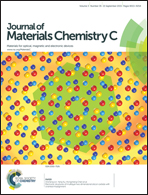High thermoelectric performance of a defect in α-In2Se3-based solid solution upon substitution of Zn for In†
Abstract
In this project, we have successfully manipulated the lattice defects in α-In2Se3-based solid solutions (In2−xZnxSe3) by appropriate substitution of Zn for In, via a non-equilibrium fabrication technology (NEFT) of materials. The manipulation of the defect centers involves reduction of the number of interstitial In atoms (Ini) and Se vacancies (VSe), and creation of a new antisite defect ZnIn as a donor. Through this technique, the lattice structure tends to be ordered, and also more stabilized than that of pure α-In2Se3. In the meantime, the carrier concentration (n) and mobility (μ) have increased by 1–2 orders of magnitude. As a consequence, the solid solution at x = 0.01 gives the highest TE figure of merit (ZT) of 1.23(±0.22) in the pressing direction at 916 K, which is about 4.7 times that of pure α-In2Se3 (ZT = 0.26). This achieved TE performance is mainly due to the remarkable improvement in the electrical conductivity from 0.53 × 103 (Ω−1 m−1) at x = 0 to 4.88 × 103 (Ω−1 m−1) at x = 0.01 at 916 K, in spite of the enhancement in the lattice thermal conductivity (κL) from 0.26 (W m−1 K−1) to 0.32 (W m−1 K−1).


 Please wait while we load your content...
Please wait while we load your content...